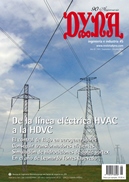STUDY OF THE EVOLUTION OF RESIDUAL STRESSES DUE TO GLASSY DEPOSITS (CMAS) ATTACK IN THERMAL BARRIER COATINGS
Keywords:
Recubrimiento de barrera térmica (TBC), esfuerzos residuales, rociado térmico, método de remoción de capa modificada para recubrimientos bicapa (MRCMPB), región de interés (Roi) y óxidos fundidos de calcio, magnesio, aluminio y silicio (CMAS), Thermal barrier coating (TBC), residual stresses, thermal spraying, the Modified Layer Removal Method for Duplex Coatings (MLRMDC), region of interest (Roi) and molten calcium-magnesium-alumino-silicate (CMAS).Abstract
This work was conceived as an integral project aimed to understand and tackle thermal barrier coating (TBC) spalling and delamination phenomena occurring in gas turbines due to CMAS attack. Such attack is thought to have an influence on the magnitude of residual stresses in the coating and, in turn, on the integrity of TBCs. A thermal barrier coating was manufactured by deposition of two layers of different chemical composition, i. e., CoNiCrAlY and yttria-stabilized zirconia (YSZ) on an AISI 304 stainless steel substrate. Both layers were deposited by employing thermal spraying processes, the bonding metallic layer (BC) was deposited by employing a HVOF gun, whereas the ceramic component (TC) by atmospheric plasma spray (APS). The TBCs were heat treated at 1250 °C, with CMAS attack by concentration of 10 mg/cm2 for different soaking times (2, 4 & 6 hours), in order to evaluate CMAS effect on the magnitude of the state of residual stresses in the coating. The stress state of the coating was determined by employing the Modified Layer Removal Method for Duplex Coatings (MLRMDC). It was noted that longer exposure times at high temperature resulted in an increase in the state of residual compressive stress in the TC, due to the effect of CMAS. Furthermore, it is confirmed that with increasing the thickness of thermally grown oxide (TGO), the magnitude of the compressive residual stresses increased. Key Words: Thermal barrier coating (TBC), residual stresses, thermal spraying, region of interest (Roi) and molten calcium–magnesium–alumino–silicate (CMAS).Downloads
Published
2016-09-01
Issue
Section
ARTICULOS

